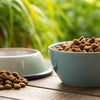Should I Mix Wet Dog Food with Dry Dog Food? A Comprehensive Guide
- Houndsy
Table of Contents
- Introduction
- Understanding Wet and Dry Dog Food
- The Pros of Mixing Wet and Dry Dog Food
- Potential Drawbacks of Mixing Wet and Dry Dog Food
- Tips for Successfully Mixing Wet and Dry Dog Food
- Special Considerations for Puppies and Senior Dogs
- Conclusion
Introduction
Have you ever wondered why your furry friend seems to turn their nose up at their dry kibble? You're not alone! According to a survey, nearly 50% of dog owners report their pets being picky eaters at some point. As devoted pet parents, we strive to provide our dogs not only with the right nutrition but also with meals that they find appealing. This leads to the common question: Should I mix wet dog food with dry dog food?
In this blog post, we will explore the ins and outs of combining wet and dry dog food. We'll discuss the benefits and drawbacks of mixing these two types of food and offer you practical tips for doing so. By the end of this article, you will have a better understanding of whether mixing wet and dry dog food is right for your pet, enhancing both their mealtime experience and overall well-being.
At Houndsy, our goal is to simplify the pet feeding process while providing beautiful, functional products like our Houndsy Kibble Dispenser. We believe that every feeding moment should be a delightful experience for both you and your dog. So let’s dive deeper into the world of dog food and feeding methods!
Understanding Wet and Dry Dog Food
What is Dry Dog Food?
Dry dog food, often referred to as kibble, is characterized by its low moisture content, usually less than 11%. It is convenient to store, has a long shelf life, and is cost-effective. There are countless varieties of kibble available designed for various breeds and life stages.
Benefits of Dry Dog Food
- Cost-Effective: Dry kibble typically has a lower cost per serving than wet food.
- Dental Health: Chewing dry food can help reduce plaque and tartar buildup on your dog’s teeth.
- Storage Convenience: Dry food does not require refrigeration and is easier to portion.
- Nutrient Density: Many dry foods are formulated to contain high levels of protein and other essential nutrients.
What is Wet Dog Food?
Wet dog food generally contains over 75% water, making it more palatable and easier to chew for many dogs. This type of food is often sold in cans, pouches, or tubs and comes in various textures and flavors, from pâtés to chunky meats.
Benefits of Wet Dog Food
- Enhanced Flavor: The high moisture content and aroma make it irresistible to many dogs.
- Hydration: Wet food can help increase your dog’s water intake, which is essential for their health.
- Easier to Eat: It’s a great option for older dogs or those with dental issues who may struggle with hard kibble.
- Variety: The different textures and flavors can keep mealtime interesting.
The Pros of Mixing Wet and Dry Dog Food
1. Variety and Appeal
Mixing wet and dry food can provide a varied diet that keeps your dog interested. Just like humans, dogs enjoy a range of flavors and textures. For picky eaters or those prone to boredom at mealtime, a mix can be quite enticing.
2. Increased Hydration
The moisture in wet food contributes to your dog's hydration, which is particularly beneficial for those who don’t drink much water. Increased hydration can support overall health, including kidney function, especially in older dogs.
3. Improved Nutritional Balance
Combining the two types of food can create a more balanced diet. Wet food often contains higher-quality ingredients, and when mixed with a nutrient-dense dry kibble, it can provide a well-rounded meal. This combination ensures your dog receives a good mix of nutrients, vitamins, and minerals.
4. Cost-Effectiveness
If your dog prefers wet food but you want to keep feeding costs down, mixing it with kibble can be a practical solution. By using less wet food while still making meals enticing, you can stretch your budget further without compromising on taste.
5. Dental Health Benefits
While dry foods are touted for their dental cleaning properties, combining them with wet food does not negate these benefits. The crunchiness of dry kibble can help clean teeth, while the wet food adds variety and flavor, ensuring your dog enjoys their meal.
Potential Drawbacks of Mixing Wet and Dry Dog Food
1. Increased Cost
Although mixing wet and dry food can be cost-effective compared to feeding solely wet food, it still tends to be more expensive than dry food alone. It's essential to consider your budget when deciding how much wet food to incorporate.
2. Proper Storage Requirements
Wet food has a shorter shelf life, especially once opened. It must be refrigerated and consumed within a few days to prevent spoilage. This requirement may be inconvenient for some pet owners, particularly those with busy schedules.
3. Possible Soggy Kibble
If the mixture of wet and dry food sits out too long, the kibble can become soggy, making it less appetizing for your dog. This can lead to food wastage. It’s best to serve fresher portions to maintain quality and flavor.
4. Nutritional Imbalance Risks
Mixing different brands or types of food without guidance can result in an unbalanced diet. It’s crucial to ensure both foods meet the necessary nutritional standards for your dog’s specific needs. Always consult your veterinarian before making significant changes to their diet.
Tips for Successfully Mixing Wet and Dry Dog Food
1. Consult Your Veterinarian
Before making any significant dietary changes, it’s wise to consult your veterinarian, especially if your dog has underlying health issues or specific nutritional needs. Your vet can provide personalized recommendations tailored to your dog's health history.
2. Ratio Matters
Strive for a balance when mixing wet and dry food. A standard guideline is to make dry food about 75% of the meal, leaving 25% for wet food. Adjust this ratio based on your dog's health requirements, activity levels, and personal preferences.
3. Gradual Transition
When introducing a new food mix, transition gradually over a week to avoid digestive upset. Start by adding a small amount of wet food to your dog's dry kibble and gradually increase the proportion as your dog adjusts.
4. Monitor Portions and Ingredients
Keep an eye on portion sizes to maintain a healthy weight. Read labels carefully to ensure that both foods meet your dog's dietary needs and do not contain harmful ingredients or excess calories.
5. Freshness is Key
Serve mixed meals immediately to ensure optimal taste and prevent spoilage. If food is left uneaten for more than 30 minutes, it's best to discard it. This practice helps to prevent bacterial growth that can be harmful to your dog.
6. Watch for Allergens
Be aware of possible food allergies or intolerances when mixing different food types. Monitor your dog for any adverse reactions when introducing new ingredients to their diet.
Special Considerations for Puppies and Senior Dogs
-
Puppies: Young dogs can benefit greatly from the texture mix of wet and dry food, making it easier for them to chew and digest. The switch to a mixed diet can occur once puppies transition from nursing but always adhere to their specific nutritional requirements.
-
Senior Dogs: Older dogs often face challenges with dental health or reduced appetite. Mixing wet and dry food can encourage them to eat while providing a softer texture that is easier to manage.
Conclusion
Mixing wet and dry dog food can be an effective strategy to enhance your dog's eating experience, promoting a balanced diet and keeping mealtime exciting. The benefits, including increased hydration and appealing flavors, often make it an attractive choice for pet owners. However, it does come with some considerations, such as cost and potential difficulties in storage.
By thoughtfully implementing these practices and consulting with your veterinarian, you can find the right balance for your beloved pet. If you're ready to streamline your dog feeding experience, don’t forget to check out the Houndsy Kibble Dispenser. Striking that balance in feeding can transform mealtime into a delightful bonding experience for both you and your dog!
FAQ
1. Is it safe to mix wet and dry dog food? Yes, mixing wet and dry dog food can be safe and beneficial for most dogs, provided you maintain balanced nutrition and monitor your dog's health.
2. What ratio of wet to dry food should I use? A common starting point is 75% dry food and 25% wet food. Adjust this ratio based on your dog's needs and preferences.
3. How can I transition my dog to mixed food? Start by gradually introducing the wet food into the dry food over a week or so to avoid digestive upsets.
4. Can all dogs eat mixed food? Most dogs can benefit from mixed diets, but dogs with specific health issues or on therapeutic diets should consult their veterinarian.
5. How do I store opened wet food? Once opened, wet food should be refrigerated and consumed within a few days for optimal freshness.












